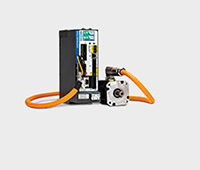By Michael Jermann, Assistant Editor
Kocsis Technologies, Inc., a manufacturer of hydraulic starters, supplies starting systems for a range of engines—from about 50 to 6000 hp. Part of its research and development effort in developing new, larger sized starters to accommodate the larger engines is applying a load equal to the mass of the engine that must be started—the load that the starter must overcome. Rather than buying commercial engines to apply this load, which would require a staggering number of engines plus installation, each time one was installed or removed, the company developed a dynamometer using an oil-shear brake from Force Control Industries. The Positorq TB20 brake applies a load that can be precisely controlled in real time, yielding accurate data even with loads of up to 8,000 ft/lb.

The new system is capable of 24/7 operations—and equally impressive is that fact that cycle times have been reduced from 2-3 minutes to about 20 seconds.
The previous design used a standard friction-style dry brake that the company could test for about two hours before experiencing brake fade (due to friction disc glazing caused by high heat).
The air cooled brake relied on a fan behind it to blow air through to help dissipate the heat. Unfortunately, the room containing the test stand was not climate controlled, so the ambient temperature would rise during testing—with the air blown over the brake also steadily rising in temperature.
Rather than trying larger dry friction brakes, the company started with a clean slate and redesigned the stand from scratch. The dry brake was replaced with an oil shear brake, which is inherently cooler running.
Fluid is pumped through the multiple disc stacks to provide both lubrication and heat dissipation. Elimination of the heat improves brake consistency, while providing longer life with virtually no adjustment required.
Normal dry brakes use a sacrificial surface—a disc or pad —to engage the load. Having no good way to remove the heat caused from engagement between the disk and plate, this material must absorb the heat. These extremely high temperatures eventually degrade the friction material and cause torque fade.
The Positorq brake consists of multiple stacks of friction discs and drive plates. Transmission fluid is pumped through the inner hub pushing the fluid through the friction stack and back into the housing where it flows into a separate Forced Lube Cooling Unit. As the plates and discs are compressed together, the fluid film is put in a state of shear and will transmit torque between the two parts.
The Forced Lube Cooling Unit consists of a reservoir for de-aeration, heat exchangers for cooling and filters for cleaning the fluid. The cool, filtered fluid continues back through the brake to complete the cycle.
Much of the heat generated is developed within the fluid in shear that is removed from the stack and replaced by cooled fluid. This eliminates fade and material degradation due to excessive heat.
Along with torque transmission and heat removal, the fluid also serves to continually lubricate all components such as bearings and splines. This cuts down on the time necessary for maintenance and increases “uptime” for the hydraulic starter test stand.
What makes all of this even more impressive is that this is a continuous slip application—meaning that the starter spins continuously under a very high load. The application is designed to slow down but never fully stop it—so it is a very severe duty cycle on the brake.
The continuous operation of the test stand is impressive, especially considering where Kocsis Technologies, Inc. started. The biggest advantage of the oil shear technology is control. The stopping force of the brake can be modulated in real time providing greater control than a standard friction brake.
Positorq brakes are quiet—noise levels of the brake system are below 65 db—which is important because test personnel are typically nearby. The totally enclosed design eliminates any contaminants to the area from friction materials or other materials.
Since the effective radius, number of discs and friction factor remains constant, the torque available is directly equivalent to the actuation pressure (air or hydraulic) furnished to the actuating piston. With multiple braking surfaces, the Positorq is not only compact but also has low inertia.
Force Control
www.forcecontrol.com
Filed Under: Hydraulic equipment + components, MOTION CONTROL





Tell Us What You Think!